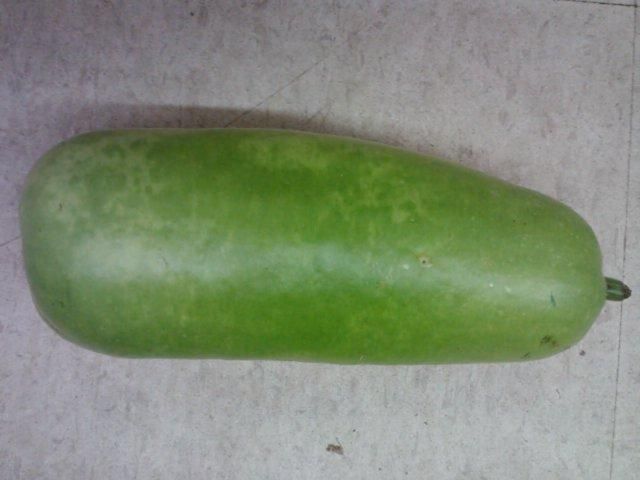Long squash (Lagenaria siceraria (Molina) Standl.) is a dicotyledon species and a member of the cucumber family (Cucurbitaceae). It is also known as birdhouse gourd, bottle gourd, calabash gourd, hard-shelled gourd, dolphin gourd, long melon, opo squash, trumpet gourd, and white-flower gourd (Lim 2012). Long squash is indigenous to Africa, but it reached Asia thousands of years ago, possibly by floating across the sea (Kistler et al. 2014). The domesticated long squash fruit were found to still contain viable seeds even after floating in seawater for more than seven months (Decker-Walters et al. 2004). DNA sequence analyses of archaeological fruit specimens suggest that long squash was domesticated for approximately 10,000 years and long before any other documented food crops. This crop was brought to the Americas by Paleoindian populations from Asia before the arrival of Columbus, approximately 8,000 years ago (Erickson et al. 2005).
Long squash is an annual, vigorous, and herbaceous crop, bearing fine hairs on vines, petioles, leaves, and young fruit. The hairs gradually fall off the plant. The leaves are heart-shaped and can measure between 4 and 14 inches in both length and width. The vine has tendrils for climbing and can be up to 30 feet in length; hence, trellis support systems are needed for high yields of good quality (Figure 1). The plants of this monoecious species bear separate flowers of both sexes, which are usually white in color. The fresh fruit has smooth, light green skin with white flesh and should be harvested young for culinary use (Figure 2). If harvested when mature and dried, the fruit will not be edible. The dried, buoyant, hard-shelled fruit have long been used as water and food containers, musical instruments (drums and flutes), fishing floats, apparel, etc. The fruit of this crop have a variety of shapes: round (called calabash), high round, cylindrical, bottle or dumbbell, slim and serpentine, or long. Most of the long squash varieties grown in Florida have long fruit (Figure 2).

Credit: Yuqi Cui, UF/IFAS

Credit: Guodong Liu, UF/IFAS
Additionally, because the long squash fruit are called calabashes, they are easily confused with the unrelated calabash tree (Crescentia cujete L.) that has stiff and hollow fruit which are also used to make containers, musical instruments, and utensils (Price 1982; Gilman and Watson 2014).
Long squash can be grown by direct seeding or transplanting of 15- to 20-day-old seedlings. The plants prefer well-drained, moist, and fertile soil. Irrigation is necessary during the growing season for a good crop. They also like a warm and sunny climate without excessive winds. Florida's climate is suitable for growing long squash for commercial purposes or in backyards and gardens. In Florida, after seeding or transplanting, this crop grows very rapidly. Cutting the vine tips when the stem is between 6 and 8 feet long can force the plant to produce more fruitful branches and set fruit much sooner. Because long squash is a relatively new crop with small acreage, IFAS currently has no standard fertilizer recommendations. Growers can temporarily use the fertilizer recommendations for cucumber: N, 150 lb/A; both of P2O5 and K2O, 120, 100, and 80 lb/A for very low, low, and medium levels of the nutrients, respectively.
Long squash is a good source of vitamin C, zinc, and potassium (Table 1). Its fruit is reported to have these medical active components: triterpenoid (biochemical compounds with 30 carbon atoms found in various plant species), cucurbitacins (a class of biochemical compounds found in some cucumber family plants) B, D, G, and H, 22-deoxy cucurbitacin ("the bitter principle of cucurbitaceae (cucumber family)"), etc. It is used as a folk medicine for its cardioprotective (heart-protective), cardiotonic (having a tonic effect on the heart), general tonic, diuretic (increasing excretion of urine), and aphrodisiac properties in certain Asian countries such as India (Upaganlawar and Balaraman 2009). Different extracts of the fruit and seeds reveal various pharmacological attributes, such as anticancer and antioxidant activity, and potential medical applications (Lim 2012).
References and Further Reading
Decker-Walters, D., M. Wilkins-Ellert, S. M. Chung, and J. Staub. 2004. "Discovery and genetic assessment of wild bottle gourd [Lagenaria siceraria (Mol.) Standley; Cucurbitaceae] from Zimbabwe." Economic Botany 58: 501–508.
Erickson, D. L., B. D. Smith, A. C. Clarke, D. H. Sandweiss, and N. Tuross. 2005. "An Asian origin for a 10,000-year-old domesticated plant in the Americas." Proceedings of the National Academy of Sciences of the United States of America 102: 18315–18320. http://www.pnas.org/content/102/51/18315.full.pdf. Accessed on February 5, 2024.
Gilman, E. F., and D. G. Watson. 2014. Amphitecna latifolia: Black Calabash. ENH238. Gainesville: University of Florida Institute of Food and Agricultural Sciences. https://edis.ifas.ufl.edu/st079. Accessed on February 5, 2024.
Kistler, L., Á. Montenegro, B. D. Smith, J. A. Gifford, R. E. Green, L. A. Newsom, and B. Shapiro. 2014. "Transoceanic drift and the domestication of African bottle gourds in the Americas." Proceedings of the National Academy of Sciences of the United States of America 111: 2937–2941.
Lim, L. K. 2012. Edible Medicinal and Non Medicinal Plants: Volume 3, Fruit. 2012 Edition. Springer Science+Business Media: New York City.
Price, S. 1982. "When is a calabash not a calabash?" New West Indian Guide 56: 69–82.
Upaganlawar, A., and R. Balaraman. 2009. "Bottle gourd (Lagenaria siceraria) 'A vegetable food for human health'—A comprehensive review." Pharmacologyonline 1: 209–226. http://pharmacologyonline.silae.it/files/newsletter/2009/vol1/028.Aman.pdf. Accessed on February 5, 2024.
USDA. 2015. USDA National Nutrient Database for Standard Reference Release 28: Full Report (All Nutrients): 11218, Gourd, white-flowered (calabash), raw. https://fdc.nal.usda.gov/fdc-app.html#/food-details/169233/nutrients. Accessed on February 5, 2024.
Whitaker, T. W., and G. F. Carter. 1954. "Oceanic drift of gourds—Experimental observations." American Journal of Botany 41: 697–700.